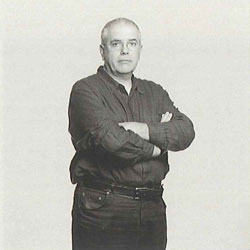Pedro Calapez
Pedro CalapezLisboa ¶ 1953
 |
|
| Créditos fotográficos / Photographic credits: Abílio Leitão |
He studied at the Fine Arts School of Lisbon and become a respected painter in the first half of the 80s through exhibitions such as Depois do Modernismo and Arquipélago (After Modernism and Archipelago). Calapez chose to move away from the quoting vortex and the scatological expression that took by storm the then so-called "return to painting". Instead, he opted for a methodological rigor, in which drawing would become his crucial practice. ¶ Creating paintings by incision making, following closely the engraver's traditional methods, the artist showed a primary interest in the pictorial/architectonic approach to space. Architecture is in fact one of the categorising references for Calapez's oeuvre. However, this architecture, merely scratched over the support's surface, shows us paths, façades, and contradictory vanishing points, generating whimsical landscapes. It is an architecture that is akin to scenography, the way it piles up its elements, and the way in which its final theatrical appearance in fact implies a staging ground. But it is a residual scenography, as it were, left behind by the actors and the narrative and the drama that one past day occupied its area. ¶ Throughout the last decade, Calapez oeuvre's architectonic vocation materialized in the form of works such as Muro contra muro (Wall on Wall, 1994), in which painted panels were erected within the gallery as corridors that directly compelled one to follow a strict path and that set up the conditions of visibility for the spectator. A similar observation-controlling effect was achieved by a recent series of objects: open-ended (lid-less) cubes with painted inner walls appeared like "painting boxes" that imprisoned the space of the visible. ¶ At the same time, the artist developed yet another line of work. His concern for textures and landscape creation is manifested also by an evermore-skilful practice of abstract painting that is completely indulged in its own pleasures of paint applying and colour management. More often than not, these paintings are presented as panels, which, by gathering multiple elements in a way that they occupy a whole wall, once again establish a privileged dialogue with the space and the light that accommodate it.
http://cvc.instituto-camoes.pt/biografias-en/pedro-calapez-49134.html#sigFreeIde2f8198a3c


